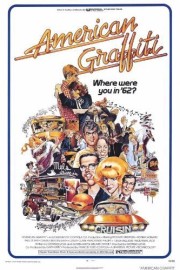American Graffiti
It’s unfair to critique George Lucas as a filmmaker solely on the basis of the “Star Wars” prequels, especially when you consider that they were the first films he had directed in over 20 years. Of course, you can’t base an opinion on Lucas on the first three films he made, either, but you can certainly make the case that before his two-decade hiatus from directing, he sure knew how to tell a story.
While “Star Wars: Episode IV- A New Hope” remains his most entertaining film, and “THX-1138” is, without question, his boldest, his second film, the ’60s-set “American Graffiti,” is arguably his most confident movie, and certainly, the one closest to his heart. Before he went to USC and became one of the most technically ambitious filmmakers of all-time, he was a car enthusiast in his hometown of Modesto, just outside of San Francisco. When Francis Ford Coppola, his friend and producer on both “THX” and “Graffiti,” bet him he couldn’t make a comedy after the miserable experience of “THX,” Lucas took the bet, and the result resonates with a heart and soul we haven’t really felt this strongly in Lucas’s work since.
In a lot of ways, “Graffiti” is the counterpoint to “Easy Rider,” the 1969 Dennis Hopper road film that helped usher in the counter-culture of artistic rebellion that paved the way for the likes of Coppola and Lucas in the 1970s. Set in 1962, this isn’t about people getting high off of sex, drugs, and rock-and-roll, although at least two of those figure prominently in the script by Lucas, Gloria Katz, and Willard Huyck, the latter two of whom brought Lucas’s most infamous bomb, 1986’s “Howard the Duck,” to the screen. (I no longer hold that against them after watching this for the first time.) “Graffiti” follows a series of small-town teenagers as they go cruisin’ through town, and getting into adventures, on the night before a couple of them (Ron Howard’s Steve, and Richard Dreyfuss’s Curt) are supposed to be heading off to college.
In a lot of ways, I’m inclined to say that “American Graffiti” actually set a template for a lot of youthful movies to come, whether it’s the rowdy comedy of “Animal House” and “Porky’s”; the sentimental teen angst of “Sixteen Candles” and “The Breakfast Club”; or the more contemporary fare of “American Pie” or “Accepted.” On their surfaces, these movies don’t have a lot in common, but they all revolve around a series of friends going through various rites of passage into adulthood. Yes, there were films before “American Graffiti” that did the same thing, but there’s something about the tone and characterizations in Lucas’s film that feel more akin to these latter films, whether you’re talking about the misadventures of Terry (Charles Martin Smith) when he is put in charge of Steve’s beloved car; the slick racer John (Paul Le Mat), and his unexpectedly offbeat journeys with a young woman (Mackenzie Phillips); the somewhat menacing Bob Falfa (Harrison Ford), a new guy in town looking to challenge John to a race; Steve’s rocky relationship with his girlfriend, Laurie (Cindy Williams), who doesn’t like the idea of a long-term “open” relationship; and Curt’s falling in with some thugs who have an illegal idea of having fun. Lucas makes the film a true ensemble piece; although Steve, Curt, and Terry are the main actors in the film, there’s an organic whole to the film that recalls another maverick from the other side of the ’70s filmmakers…Robert Altman.
We won’t know what kind of filmmaker George Lucas would have been had he NOT made “Star Wars,” but if “American Graffiti,” with its unforgettable rock soundtrack and flat-out fantastic cameo by radio personality “Wolfman” Jack, is any indication, we might have missed out on a wonderful storyteller in the best tradition of his friends from this “golden age” of cinema. Maybe he’s still in there, and if not, at least we can look back at this film, and smile along with the characters, who have found their place in the world by the time the credits roll.










